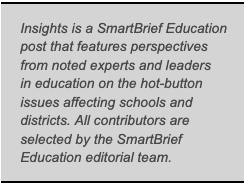
As educators, we’ve become quite adept at applying culturally relevant content in our classrooms. But what about using inclusive content in assessments? For many of us, that’s still a work in progress. Ensuring diverse cultural representation in student assessments is a more recent undertaking compared to classroom instruction. It can be especially difficult to apply when you consider the many opportunities there are to introduce distracting or irrelevant content that can potentially disadvantage test takers.
The good news is that as an education community—teachers, school leaders, district staff, and vendors—we’re rapidly developing the digital tools and expertise to deliver more culturally relevant assessments. We know that students perform best when they can learn and demonstrate their knowledge in a manner that is relevant to them. It is, therefore, a matter of educational equity that we continue this work, taking steps wherever possible to ensure instructional and assessment content reflects the experiences of all students.
My colleague and I recently examined the value of inclusive content in assessments, as well as some of the methods and tools for creating it. Below are key insights to help guide the creation of culturally relevant content.
The why of inclusive assessments: A mirror, window and accurate assessment
All students deserve to be uplifted, their cultures celebrated, and their stories amplified. As an education-software vendor, we strive to create content that offers students mirrors and windows. These “mirrors” should reflect familiar aspects of students’ identities. At the same time, it’s important to give students a window into the traditions and practices of others. Learning about the many beliefs and customs practiced around the world contributes to a more tolerant and open-minded society.
Such inclusive content importantly provides a more engaging assessment experience.
Culturally relevant assessments can also allow for more accurate assessment of learning. These assessments use equivalent constructs to measure mastery while adjusting the supporting context materials and response format to make them relatable to a wider audience. Unfortunately, in an effort to maximize comprehensibility, it’s not uncommon for assessment developers to try to eliminate cultural references altogether. But making sure that contextual items cover only “general” knowledge means inadvertently centering content on the most mainstream culture. By design, this excludes representation of historically marginalized cultures, missing opportunities for these students to feel seen, valued, and included in the content. Further, culturally responsive assessments provide more accurate measures of student learning by allowing students to demonstrate their skills in a manner that is relevant to them.
As an education community, we must continue to explore best practices for creating assessments that are both bias-free and culturally enriching. Whether you’re a developer or an educator building your own assessments, applying culturally responsive practices can help improve student engagement and enable more reliable assessment results.
The how: First, focus on quantity and quality
When developing culturally relevant assessment content, educators look for opportunities to increase both the quantity and quality of content that represents diverse groups. We can introduce diversity in many ways, from the books and passages we select for quizzing to the language and context we write into assessment items.
Inclusive assessments have representation across many dimensions of identity, particularly those dimensions most salient to the people being assessed. Given that components of racial and ethnic identity develop during different stages of childhood, it is possible that students may identify more strongly with other dimensions of identity at young ages. This does not deprioritize the need for diverse racial and ethnic representation in content but, instead, emphasizes the importance of considering additional factors that contribute to one’s identity when determining how well content represents students.
Other dimensions of identity to consider may include socioeconomic status, religion, ability, neurodiversity, geography and neighborhood settings (e.g., urban, rural, suburban), gender, age, family structure and more. This can be a great way to highlight commonalities (and also increase relevance) across dimensions of identity.
The how: Next, measure and analyze
Developing truly inclusive assessments requires more than counting the number of historically marginalized people in content; it also considers how well we represent them. Representation of all groups, especially historically marginalized populations, should be accurate, respectful and appropriate. Stories, settings and events should uplift and empower students in an authentic way.
Whereas the golden rule encourages us to treat others the way we wish to be treated, educational content developers must exercise the platinum rule of treating others the way they wish to be treated.
One way this can be done is by ensuring the people represented in the content are included in the content development process. During the beginning of the assessment development process, content teams benefit from co-creating sample assessment items with members from different communities to ensure authenticity and relevance in representation. This is also an ideal time to understand students’ preferences for demonstrating their mastery. Large-scale assessments typically take a multiple-choice format, but, when possible, assessment providers should explore how to vary the format of assessments to accommodate the many ways students prefer to demonstrate their understanding (e.g., open-ended questions).
After the content is developed, the team may benefit from working with education stakeholders — perhaps via an advisory board of professionals with DEI-related education experience — to conduct thorough reviews of product content, provide qualitative feedback on the current state of content and identify next steps for increasing inclusion and representation. No team, no matter how diverse, will have representation of all possible identities and intersections of those identities. Therefore, it is critical that assessment developers understand the needs, interests and preferences of the communities they wish to represent if they are planning to develop culturally inclusive content.
Developing representative content also requires ongoing measurement and analysis. Regular audits of representation in assessment content and comparison of that data to national demographics can help measure how well content reflects the population at large. Assessment creators should consider representation across grades, subjects and genres and develop strategies for increasing representation. For example, whereas literary texts (stories, dramas, poetry) can use characters, situations and language to normalize diversity, informational texts might feature a wide array of topics and historical events that represent and include many different cultures, perspectives and experiences. Assessment developers should always be on the lookout for uneven or disproportionate representation in both types of text, and they should adjust content priorities for improved inclusiveness.
Culturally enriching assessment content can increase interest and engagement while providing relatable context to questions or items. Historically, a fear of introducing bias has prevented assessment developers from exploring how to implement culturally responsive assessment practices, but this can be done in a way that is accessible to students who do not practice that culture.
Assessments can be both fair — meaning that items should be equally challenging to all students — and culturally enriching. By following this practice, educators can provide windows and mirrors for their students. We know the benefits of allowing students to learn new content in a culturally relevant way. It’s time to allow students to express their mastery in a culturally relevant way as well.
Opinions expressed by SmartBrief contributors are their own.
Subscribe to SmartBrief’s FREE email ASCD newsletter to see the latest hot topics in education. It’s among SmartBrief’s more than 250 industry-focused newsletters.
